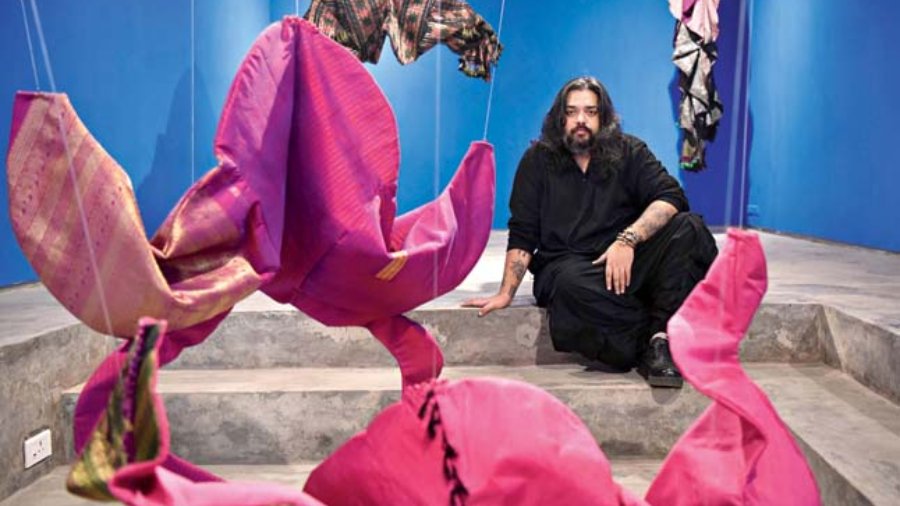For Kallol Datta, the crux of clothes-making has never been about geometry, as testified by his preoccupation with native clothing practices such as shrouding and veiling, originating in the regions of south-west Asia, north Africa, the Korean peninsula and the Indian subcontinent. And this anthropological approach towards making clothes is more often than not research-based than it is production-centric. In fact, Kallol, of his own admission, has been “thinking a lot about production, the labour involved, clothing and demand — and how so much of it ends up in landfills”. This, combined with his curiosity about the cultural significance of clothing, led him to Volume 3 Issue 2 in the form of a curated showcase featuring 17 “objects” that opens for preview today evening at Experimenter’s Hindustan Road gallery.
As an extension of his larger work, this particular project began with research at SOAS London, followed by a residency at Aomori Contemporary Art Centre in Japan that sowed the seeds of his work — both with and about — the clothing practices of Japan’s late Showa era (1945 to 1989). “I decided to have a clothing drive in Aomori for native clothes from the late Showa period. It was a very interesting time as it was a period when things became very difficult for them. Parallely, I started a clothing drive in India, calling for saris belonging to the same period,” said Kallol, when I caught up with him at the gallery recently. While clothes collected in two different regions helped him juxtapose both the cultures through their stories as well as their material and fabric, it also enunciated Kallol’s practice of playing with form and materiality. However, his practice is as rooted in process and research as it is in emotion as both the clothing drives were accompanied by his thirst for stories associated with the items of clothing. “I asked the donors for interviews or to write me letters or send me images,” he added.
The production of this project thus began, which Kallol explains as: “It is almost like reproduction happening because I am deconstructing every piece received and then reconstructing and piecing them together, after drafting patterns.” The show at Experimenter has been curated in a way that each “object” — as Kallol refers to them — is essentially an installation, with some suspended from the ceiling and some mounted on walls. Form and silhouette are secondary as Kallol is happy to leave them open for interpretation — and as if on cue, I overheard Experimenter co-director Priyanka Raja likening a series of brass works that are a part of this exhibition to amorphous objects on the seabed.
In fact, distortion of form is deliberate as he explained his “profusion of decorative elements”. “I have a lot of friends who are activist-artists and we have always spoken about the role of aesthetics in resistance, especially in today’s context. Therefore, wherever decorative elements are introduced in my works, they have a purpose — wherever they are introduced, they alter the behaviour of the fabric,” he explained. A good example of this would be a piece in this exhibition made of ikat, whose appendages follow the pattern that was drafted for it but they behave differently because of the insertion of tassels and the presence of loops.
Kallol’s reservation about not being called a “fashion designer” is well-known but one must note that it doesn’t stem from a distaste for it. Instead he refers to the act of being called one as a “disservice” to other designers. “I don’t function in the way other designers do and doing fashion shows gave me unnecessary stress. What I do is more of pattern-and-clothes-making,” said Kallol, who showed last on the runway in 2016. Then it begs the question that what about an art gallery puts him more at ease than a runway? “I don’t think about humans while I am drafting my patterns. I can’t even say that they are the last thing on my mind because I don’t acknowledge them at all! When I am making clothes that are not meant to be worn, we can either look at it as social commentary or for forming an emotional connect with the viewer or with the person who eventually owns that object — and this is why I have been terming my pieces as objects since 2016,” answered Kallol, who has returned to Experimenter for the second time since his first solo here in 2017.
The fact that a Kanjeevaram and an ikat sari were used to create shapes that could be reminiscent of anything from Palestinian kaftans, Sudanese thobes, Persian mantos, Korean hanboks or the Japanese haoris further validates Kallol’s research into native clothing practices as he said, “At the end of the day when you distil each of these native-wear shapes down to their purest template-like forms, they are all so similar.” He went on to cite parts of his research, especially his deep-dive into the works of press photographer Shoichi Kudo, that helped him draw parallels of imperial edicts regarding clothing in Japan with other parts of the world such as the diktats of the Ayatollah of Iran. And it can be seen till today with regards to the politics of clothing in 2022.
Meanwhile, as Volume 3, Issue 2 opens to the public at Experimenter, Kallol’s larger project is still in continuation as he admits that he is soon going to “run away” again to research. And I, for one, can’t wait to watch what he does next.
